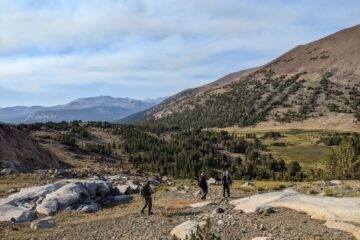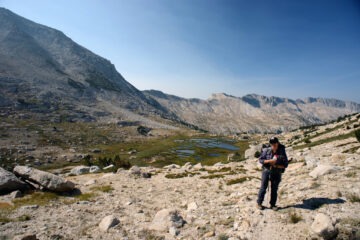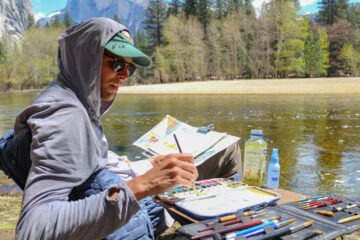Success during 2022 Yosemite Field School: Bighorn Sheep Backpack!
Dates: August 11- 14, 2022
Trailhead: Mono Pass
Highlights: We saw sheep!
Three key elements contributed to the overall outstanding success of the Yosemite Field School: Bighorn Sheep Backpack — the quality of the trip leaders, the abundance of wildlife sightings, and the engagement of participants.
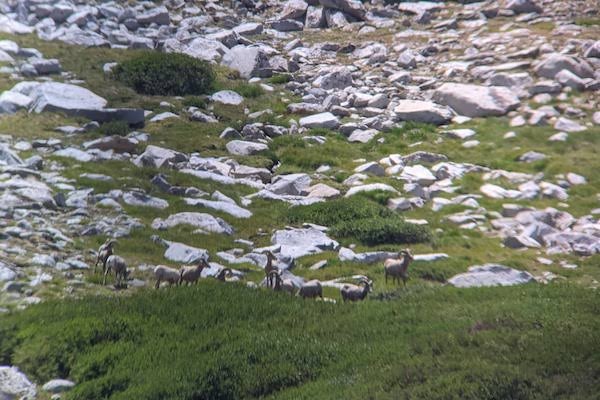
Herd of Sierra Nevada bighorn sheep spotted during backpacking trip.
Trifecta of Trip Leaders
On an average Conservancy backpacking trip there are two naturalist guides. On this trip, there were three. Our two subject matter experts were Sarah Stock, a wildlife biologist for Yosemite National Park, and John Wehausen, president of the Sierra Nevada Bighorn Sheep Foundation. Between Stock and Wehausen, our guides reflected nearly seven decades of research and study of wildlife in the Sierra Nevada.
As a wildlife biologist for the park, Sarah Stock’s career in Yosemite includes work with a great diversity of creatures from butterflies to bighorns. She participated in the re-establishment of the Cathedral Herd (TED Talk). While this trip focused on the Sierra Nevada bighorn, her additional observations of butterflies and pikas helped to paint a fuller picture of the alpine community.
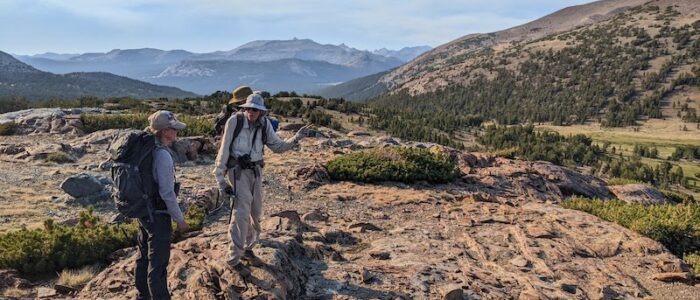
Sarah Stock and John Wehausen discuss strategy of where to look for sheep.
John Wehausen has studied bighorn sheep specifically since 1974 and his depth of knowledge is endless. From the evolutionary history of the sheep family to the unique qualities that make Sierra Nevada bighorns alpine specialists, he relayed complex information with enthusiasm. He retold the creation story of the Sierra Nevada bighorn sheep recovery plan that he wrote, and is currently working to ensure the longevity of this species.
In addition to the subject matter experts, Conservancy Naturalist Andrea Canapary completed the trifecta of talented guides on this trip. An additional beacon of knowledge regarding the natural history of the High Sierra, Canapary focused her attention during this trip on checking in on the group – making sure everyone was enjoying the experience and had everything they needed. From setting up dinner circles to updating itineraries, Canapary made sure the trip ran smoothly and that everyone’s needs were met.
Where the Wild Things Are
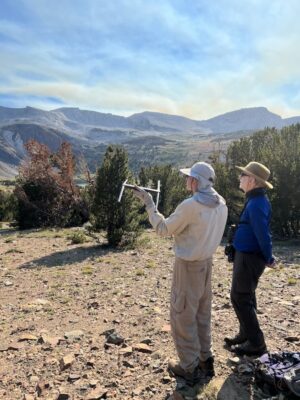
John Wehausen demonstrates the telemetry device for a trip participant.
Our Sierra Nevada bighorn sheep sighting was the penultimate achievement of the weekend. On that Saturday, we hiked over to the shores of Helen Lake, guided by Wehausen’s telemetry signals. With spotting scopes and binoculars, we scanned the talus slopes across the way — success! One, two… At one point we counted 11 rams grazing and resting in the snow-fed meadows. We nestled in, enjoyed an extended viewing session, taking turns with the more powerful scopes to observe the rams at work.
Wehausen explained that at this point in the year, the sheep were divided into herds of ewes and rams. They would reunite only for mating season in the fall and winter. Along our hike to Helen Lake, he identified the plant species of the sheep’s diet — we even got to taste one for ourselves — a spicy leaf of the Mountain sorrel.
Sunday morning before hiking back to the trailhead, Stock led us down into Bloody Canyon so we could learn about other animals that share the alpine habitat with the bighorns – pikas. This alpine rabbit species lives in rock piles above 10,000 feet elevation and gathers bundles of alpine wildflowers to survive the long winter.
In addition to the mammals, Stock helped to identify a variety of butterflies including: a Mormon fritillary, a Sierra Sulphur, and a Shasta blue. Red tailed hawks soared over head and Clark’s nutcrackers were never far off. We also observed Pacific tree frogs, also known as Pacific chorus frogs, minuscule amphibians bouncing through dewy blades of grass.
Community of Learners
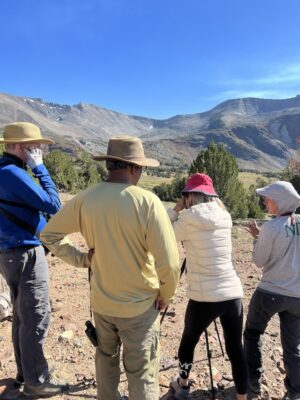
Sarah Stock explains bighorn sheep behavior to participants.
Starting out on this trip, we were all strangers brought together by our interest in Sierra Nevada wildlife. Through both the formal learning and informal conversations, intellectual curiosities were piqued through thoughtful dialogue and inquiry.
Photographers organized sunrise hikes to an east-facing lookout, meal time conversations shifted between philosophies of conservation and advocacy, to sharing personal backgrounds. And everyone loved asking Wehausen questions that would launch into a 30-minute answers.
In addition to learning about alpine wildlife, we also delved into wilderness ethics and practiced off-trail explorations. We learned methods to minimize our impact on the delicate ecosystem as well as how to navigate across the rugged landscape.
The Tradition Continues
Yosemite Conservancy’s Yosemite Field School programs carry on a tradition that is nearly a century old. These trips provide the opportunity for lifelong learners to gather in the mountains and share our curiosity and wonder with guides and experts who are excited to share their knowledge and expertise. There is no substitute for being in the field, especially when the field setting is Yosemite National Park.
The Yosemite Field School series is now complete for 2022. Below are the Yosemite Field School Trips for 2023… maybe we’ll see you there?

Yosemite Conservancy guide Andrea Canapary left and participant on right using binoculars and scopes to look for sheep.
Yosemite Field School 2023
Yosemite Valley Geology led by park geologist Greg Stock, March 24, 2023
Teach the Teachers led by Conservancy’s Lead Naturalist Cory Goehring, April 8 to 9, 2023
Ethnobotany led by Conservancy guide Marina Hansen, May 13 to 14, 2023
Meadow Hydrology and Ecology led by Conservancy guide Dan Webster, May 19 to 20, 2023
Bird Behavior, Nesting, and Communication led by Conservancy guide Andrea Canapary with a special guest park biologist with the peregrine falcon monitoring project, June 3 to 4
Bird-Banding led by Conservancy guide Andrea Canapary with special guest park wildlife biologist Sarah Stock, June 8 to 10, 2023
Butterflies and Pollinators led by Conservancy guide Marina Hansen, July 28 to 29, 2023
Alpine Amphibians Backpack led by Conservancy guide Andrea Canapary with special guest Roland Knapp of SNARL (Sierra Nevada Aquatic Research Laboratory), July 27 to 30, 2023
Bighorn Sheep Backpack led by park wildlife biologist Sarah Stock with special guest John Wehausen of the Sierra Nevada Bighorn Sheep Foundation, August 24 to 27, 2023
Tuolumne Meadows Geology led by park geologist Greg Stock, August 25 to 27, 2023
Geology Backpack to Lyell Basin led by Conservancy guide Andrea Canapary, August 31 to September 3, 2023
Photos by Yosemite Conservancy/Hv

